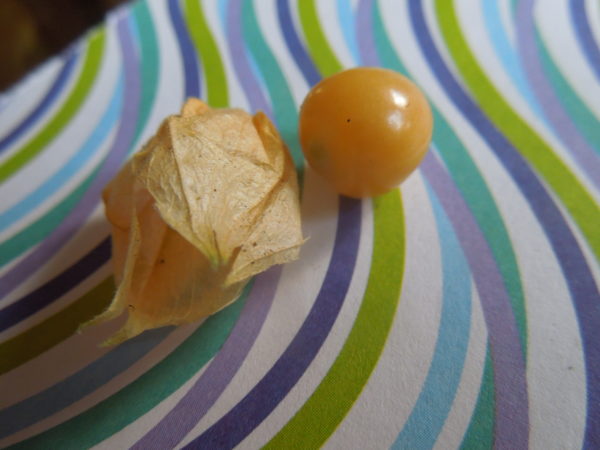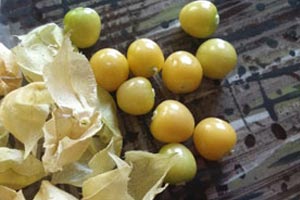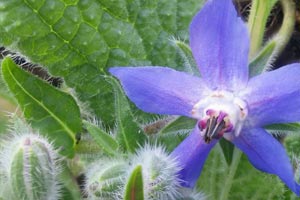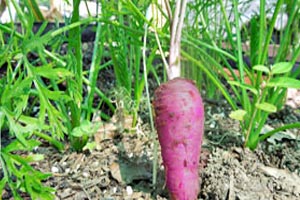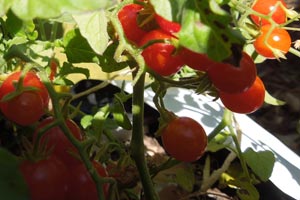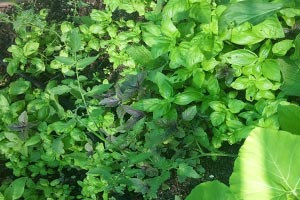It’s never too soon to start planning a garden. Around here, including in the dead of winter, we’re growing year round! To make it even more fun, we’ll be creating a new garden this winter and spring at an elementary school in North Texas. As you can imagine, the seeds used in a school garden require some thought to accommodate for an abbreviated growing season while at the same time providing an opportunity to stretch the imagination.
Let’s start with the home plot and a collection of edibles that provide food, drink and harmony in the garden. All the varieties I’m listing are available to the public, are heirloom and/or organic, and can be adapted to many climates. I prefer organic seed but there are cases where rare seed varieties have not officially been certified organic because of government red tape. More suppliers are opting out of the daunting and costly process of certifying their seed although they use organic practices in the field. I’ll let you know if something is not organic.
1. GROUND CHERRIES (AKA Cape Gooseberry, Husk Cherry)
Delightful and a challenge for the mind and taste buds, ground cherries were a pleasant surprise in my garden last season. Not a challenge to grow from seed at all. Ground cherries belong to the same family as tomatoes the nightshades, and grow very similarly except that they need no staking. Family visiting found it fun to search the ground for the husk covered fruits. If you’re looking to amp up the nutrition in your life, this “peel and pop in your mouth” fruit allows you to take in a bunch of health benefits (Vitamin A, B, C, calcium, iron and protein) while you tilt your head in wonder at how to describe its taste. My brain tells me they have a tart pineapple flavor, hint of strawberry and the consistency of a cherry tomato. Varieties I’ve seen from Baker Creek (RareSeeds.com) include Aunt Molly’s and Strawberry Husk. At only $2.50 a packet, these easy growers also work well in containers. Although not a tomatillo technically, GrowOrganic.com has them listed as such. For the least expensive organic option, select the packet for $1.99 containing 50 seed. They suggest dipping them in chocolate for an “unusual dessert”. How peculiar, anything dipped in chocolate is usual to me.
2. BORAGE
This hairy, droopy, sometimes gangly herb is my #1 go-to plant in the home garden. Are you sick of me praising it up on Facebook and my website? So sorry, you’ll have to put up with it again – I’ll try to tone it down. When I hear people whine that borage is invasive I smile and rejoice with the knowledge that it is easy to control, easy to grow (from rich to poor soils) and easy to repurpose as a fertilizer, green manure and soil amendment. By placing this plant in several spots in your garden, you are essentially growing a universal companion plant (to strawberries, tomatoes, cukes, gourds and fruit), a soil conditioner, pollinator magnet, potential pest trap, herbal tea delight, edible flower factory and soil drill. (That taproot helps loosen up hard ground.) A surprising fact about this plant is that it can remain healthy in cold weather. I have seen it unscathed in 35 degree temps and has had snow on top of it this winter! Contrary to seed seller guidance, it will grow in less than full sun. Where to buy from my experience? I’ve found this seed will last for years if stored in a cool, dark place in indoor temps. My first bulk order was from Seed Savers Exchange and I am very happy with the quality and longevity. For a first time borage-grower I would recommend a small packet with 100-200 seeds and expect to pay no more than $4.50 for organic seed. These suppliers carry certified organic borage: Johnnyseeds.com $4.20, Botanical Interests.com $2.39, GrowOrganic.com $1.99 (Coupon for GrowOrganic.com for free shipping until 1/16/2016. Code: CGh76g)
3. COSMIC PURPLE CARROT
The best tasting carrot from my kids’ perspectives, Cosmic is “cool and crunchy”! Purple on the outside and orange with yellow rings on the inside, Cosmic causes colorful comments around here: “crazyamazingbaby”, “sweet and spicy and spikey”, “tastiliscious”. Rareseeds.com has a packet of 300 seeds for $3.00.
4. MALABAR SPINACH
Spinach that grows on a vine? Well, sort of. It is not technically spinach but it does grow on a vine and tastes like a succulent version of the green. Who wouldn’t love a green that grows vertically. I’m straying a bit from lettuce finding that there are loads of leafy options. To make it even more attractive, Malabar Spinach produces seeds that you can use to dye crafts and fabric. You’ll eat more salads and produce your own magenta stain. Try saving the seeds in the refrigerator and use them months later to dye Easter eggs! I bet this specific tip doesn’t exist on Pinterest yet. Hint, hint, Cindy…
5. EXOTIC SWEET POTATOES
This year I’ll be growing loads of sweet potatoes because they taste better when they’re homegrown and I can freeze extra. In the past I’ve nurtured my own sweet potato slips along by cutting sections off organic sweet potatoes that have sprouted in the cupboard then transferring them to containers of potting soil to create long runners with many eyes or sprouts on the sides of the stem. Check out rare heirloom types at RareSeeds.com: Molokai Purple (Hawaiian), Okinawan Purple (Japanese) and Omani Pink (Omani). Three plants of one variety cost $9.00 or opt for their Rare Collection at $12.00. Most suppliers of sweet potato slips ship late spring, around May. Southern and warm climate gardeners, try Southern Exposure Seed Exchange for a nice selection of certified organic varieties.
6. TOMATOES
Of course we’ll be growing tomatoes, but what varieties? First off I need to say !!!nanny, nanny boo boo!!! to my neighbors who told me the only varieties that grow in our extreme heat are the hybrids offered at Lowes and Home Depot. I proved them wrong without a doubt. My chosen attitude of ignorance has served me well because last season heirloom chocolate cherries were fantastic and an heirloom variety of yellow pear kept going until New Year’s Day! The secret sauce is patience. Most people pull their tomatoes when the hottest days drag them down and don’t realize that the plants are just hibernating and gearing up to go BAM! So, have an open mind and don’t be a hasty harvester this year. Try something new and please NEVER USE “Miracle” brand bagged soil mixes! These laboratory concoctions contain little organic matter. The large doses of synthetic chemicals produce shots of growth creating lots of foliage but less fruit. By growing too vigorously in spurts, the plant is weaker and less apt to fend off disease and pests.
Starting tomato seed is a cinch. Warm bottoms, covered cups and in 2-3 days they will sprout. I will post my technique soon.
My tomato varieties for 2016: Chocolate cherry (rave reviews from friends and family so it must return), Tess’s Land Race (tiny clustering tomatoes made my kids happy all summer and fall), Yellow Pear (took over the garden and lasted through December), Ananas Noire/Black Pineapple (huge, psychedelic-colored fruit from Belgium), Cosmic Eclipse (great color transformation and streaking in green, indigo and red plus a great vine longevity (remember I ignore my garden sometimes and need to come back and find edible fruit).
7. OKRA
Okra is AOK now that I’ve learned it does not need to breaded to be enjoyed. Greasy foods don’t work for me anymore. In fact, they make me not work. Did you know okra sliced lengthwise and sauteed in olive oil and garlic is divine in a dish? Add herbs and spices or keep it simple. Are you like me and get a lot of satisfaction out of growing food that costs an arm and a leg at the grocery store. Okra is one of those plants that will pay for itself. Try exotic and heirloom varieties, then save the seed from mature pods for next year and to share with friends. Did you know that Okra flowers are edible. Oh happy day! A chance to invent something new at my house…maybe stuffed okra blossoms. My husband will try anything — he’s a gem. GrowOrganic.com has two varieties to choose from, a red and green. Or browse on RareSeeds.com for more exotic types like Jing Orange. There’s an entire scrolling page of okra varieties!
8. TATSOI
Like I said, I’m getting away from lettuce because it is so one-dimensional. I want to be able to dance with my greens and try lots of new things. I can wrap lettuce leaves, rip them up and drizzle with salad dressing. How about a green that can be stir fried and used in salad? Tatsoi is the friendly Asian green. Not everyone likes the spice and kick of mustard greens. Tatsoi has a mild cabbage flavor and grows in a loose rosette formation. My kids will eat the leaves raw while frolicking in the garden. We all need to frolic more don’t you think? It’s interesting how a “k” is added to “frolic” when using it in the present participle tense. Seems that is a rule. When a word ends in “c”, a “k” is added before “er”, “ed” or —“ing”. Examples: picnic, mimic, traffic. What is this a grammar lesson? I digress. I’ll end it on an exciting note. Tatsoi leaves make great baked chips. I’ve made chips out of nasturtium, kohlrabi, kale and Swiss chard leaves, why not? Use the recipe for kale chips found here — just don’t rip up the leaves of tatsoi since they are so small.
9. EXOTIC TYPES OF BASIL
Is there ever enough basil in the garden? Using it fresh is fantastic and any extra leaves can be frozen as whole leaves or chopped and combined with olive oil in freezer cube trays for use as pesto and herb flavoring during the cooler months.My new favorite has large flavorful foliage and is called Lettuce Leaf Basil. Check out these varieties: Amethyst, Bolognese Aurelia, Christmas Basil, Cinnamon, Corsican, Dark Purple Opal, Genovese, Greek, Holy Basil, Italian Cameo, Licorice, Lemon, Lime, Purple Ruffles, Spicy Bush and Thai Basil. Any of the seed suppliers will feature at least a few different types and it is easy to get organic basil seeds.
10. SUPERSCHMELZ GIANT KOHLRABI
It’s depressing to forget about the garden and find that the kohlrabi has grown too big and become woody. This variety allows me to be absent-minded and lazy. If you’ve never grown kohlrabi before I highly suggest you give it a try. With limited space, you can get more food on one plant. Bulbs of kohlrabi grow like a turnip but at soil level. The taste is of cabbage, turnip and apple combined depending on the variety you grow. White and purple types are common. Sliced it can be sautéed and eaten raw. My kids love roasted chips made from the leaves more than they like kale chips. Get a recipe and more info about kohlrabi here.
11. ASIAN WINGED BEAN
Guess I just can’t help myself when it comes to different vegetables and fruit. Imagine a bean that looks like a tiny pontoon boat! They need warm temps to flourish. High in protein, this bean follows the Chinese Red Noodle Bean that I grew last season successfully. Check out this video on YouTube I have a link to a video made by another lady on my website. It is the best video I have found on growing Winged Beans:
I’ve got more – the list goes on. Come back and read more about what we’ll be growing in 2016 to include:
Loofah Gourd – we are sponge fanatics!
Lemon Cucumber – my kids’ favorite cuke!
Phoenix Nasturtium – a frilly nasturtium!
Red Clover Sprouting Seed – Grow your own sprouts in a safe environment in your home.
Pusa Gulabi Radish – I need a mild radish and this one is strikingly beautiful, large and easy on the tongue.

